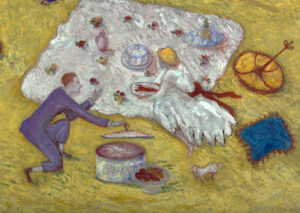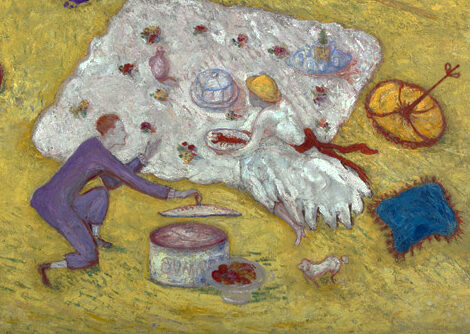Stettheimer liked whimsy and humor in her paintings but included jokes only her friends would recognize. Her outlook is surreal. She preferred the outdoors, like Picnic in Bedford Hills, because interiors are less joyful than an outdoor scene.
Like Matisse’s The Red Studio (1911), Stettheimer’s perspective for Picnic is flat, and the coloration is slightly odd, especially the yellow grass. The picnickers have wispy insect-like bodies posed as if leaning uphill. Marcel Duchamp, in purple, seems about to spring up and fly away. Stettheimer’s sister Carrie, in white, looks about to leap onto the white picnic cloth. Above the apex of the cloth Stettheimer, in red, and Elie Nadelman, in tan, recline on a carpet near a willow that casts no shade. Stettheimer’s sister Ettie, in white, sits alone on a red rug holding a white parasol for shade.
The picnic food is unappetizing and spread on the cloth like daubs of color on an artist’s palette or a connect-the-dots game. Except for Duchamp and Carrie, who are serving lobster, only the small white dog eyeing the lobsters seems interested in food.

Farmers harvesting crops in the dim background suggests Stettheimer’s disinterest in mundane work and maybe her affirmation of financial independence.
Featured Image: Virgil Thompson called Stettheimer’s style “high camp.” Florine Stettheimer. Picnic at Bedford Hills (1918), oil on canvas. Pennsylvania Academy of the Fine Arts Philadelphia, Pennsylvania
See Stephen Brown and Georgiana Uhlyarik. Florine Stettheimer: Painting and Poetry. New Haven: Yale University Press, 2017; Henry McBride. Florine Stettheimer. New York: The Museum of Modern Art, 1946; Barbara Bloemink. “Florine Stettheimer: Becoming Herself” UC Press E-Books Collections, 1982-2004; Barbara J. Bloemink. The Life and Art of Florine Stettheimer (New Haven, Connecticut: Yale University Press, 1995); Virgil Thompson. The Autobiography of Virgil Thompson. New York, E.P. Dutton, 1966.

